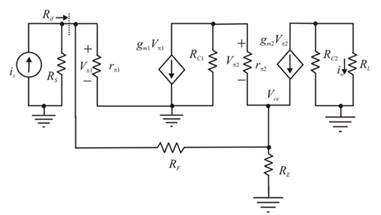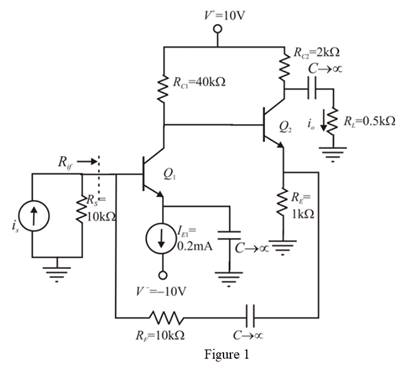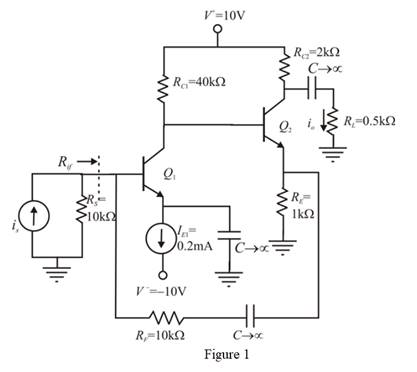
The circuit in Figure P 12.49 has transistor parameters:

the small-signal parameters for
(a)
The value of the small signal parameters for
Answer to Problem 12.49P
Thevalue of small signal resistances are
Explanation of Solution
Given:
The given diagram is shown in Figure 1

Calculation:
The small signal circuit for the given circuit is shown in Figure 2.

Figure 2
The expression to determine the value of the current
Substitute
The expression to determine the value of the voltage
Substitute
The value of the current
Substitute
The expression to determine the value of the current
Substitute
The expression for the small signal input resistance is given by,
Substitute
The expression for the trans-conductance of the first transistor is given by,
Substitute
The expression for the small signal input resistance is given by,
Substitute
The expression for the trans-conductance of the first transistor is given by,
Substitute
Conclusion:
Therefore, the value of small signal resistances are
(b)
The value of small signal closed loop current gain.
Answer to Problem 12.49P
The value of the small signal closed loop current gain is
Explanation of Solution
Given:
The given diagram is shown in Figure 1

Calculation:
Apply KCL at the source.
Substitute
Consider the KCL equation.
Substitute
Apply KCL at
Substitute
Substitute
Substitute
Substitute
The expression to determine the value of the output current is given by,
Substitute
Substitute
Conclusion:
Therefore, the value of the small signal closed loop current gain is
(c)
The value of the resistance
Answer to Problem 12.49P
The value of the resistance is
Explanation of Solution
Given:
The given diagram is shown in Figure 1

Calculation:
Substitute
The expression to determine the value of the input resistance is given by,
Substitute
The expression to determine the value of the input feedback resistance is given by,
Substitute
Conclusion:
Therefore, the value of the resistance is
Want to see more full solutions like this?
Chapter 12 Solutions
Microelectronics: Circuit Analysis and Design
- 4) Find the valve of current if using nodal analys.3. (write and then solve the set of equations toget current Ex from your voltage variables.) M 3 ча + GA हुप 8Aarrow_forward2) Write but do not solve the set of Nodal equations for this circuit. 35 34 M x www 2 3A ↑ -+ 1v {7 ww 6 Bixarrow_forward3) Write: but do not solve the set of Nodal equations. for this circuit. m 4 13 35 23 ZA 5 M 8V (±) 6arrow_forward
- Feedback and open-loop gains. کا ✓ = B= S R1 ww C1 C2 R2 ww derive the oscillation frequency,arrow_forward1) Write but do not solve the set of Nodal equations for this circuit. 12 m 8 4A √3 ww www 6 ±7V 5 हुप Дам V 1 3 mmm 2Aarrow_forwardUse Gauss elimination method to find I₁, I2 and I, for the circuit shown below, if 60 12 Ω 80 13 4Ω 32V 16 Ωarrow_forward
- solve in detailarrow_forwardProblem 5 Plot the impulse response of the system shown below. Hint: This is done graphically with 4 convolutions. x[n] D y[n]< D D D D D D D D D D Darrow_forwardProblem 3 Assume that a[n] and y[n] satisfy the relation y[n] = −x[n−2]+h[n−2] * x[n+1] h[n] -3-2-10123 n where h[n] is shown in the figure. Can we equivalently write that y[n] = g[n] * x[n] for some sequence g[n] ? If so, plot g[n]. If not, explain why.arrow_forward
 Introductory Circuit Analysis (13th Edition)Electrical EngineeringISBN:9780133923605Author:Robert L. BoylestadPublisher:PEARSON
Introductory Circuit Analysis (13th Edition)Electrical EngineeringISBN:9780133923605Author:Robert L. BoylestadPublisher:PEARSON Delmar's Standard Textbook Of ElectricityElectrical EngineeringISBN:9781337900348Author:Stephen L. HermanPublisher:Cengage Learning
Delmar's Standard Textbook Of ElectricityElectrical EngineeringISBN:9781337900348Author:Stephen L. HermanPublisher:Cengage Learning Programmable Logic ControllersElectrical EngineeringISBN:9780073373843Author:Frank D. PetruzellaPublisher:McGraw-Hill Education
Programmable Logic ControllersElectrical EngineeringISBN:9780073373843Author:Frank D. PetruzellaPublisher:McGraw-Hill Education Fundamentals of Electric CircuitsElectrical EngineeringISBN:9780078028229Author:Charles K Alexander, Matthew SadikuPublisher:McGraw-Hill Education
Fundamentals of Electric CircuitsElectrical EngineeringISBN:9780078028229Author:Charles K Alexander, Matthew SadikuPublisher:McGraw-Hill Education Electric Circuits. (11th Edition)Electrical EngineeringISBN:9780134746968Author:James W. Nilsson, Susan RiedelPublisher:PEARSON
Electric Circuits. (11th Edition)Electrical EngineeringISBN:9780134746968Author:James W. Nilsson, Susan RiedelPublisher:PEARSON Engineering ElectromagneticsElectrical EngineeringISBN:9780078028151Author:Hayt, William H. (william Hart), Jr, BUCK, John A.Publisher:Mcgraw-hill Education,
Engineering ElectromagneticsElectrical EngineeringISBN:9780078028151Author:Hayt, William H. (william Hart), Jr, BUCK, John A.Publisher:Mcgraw-hill Education,





